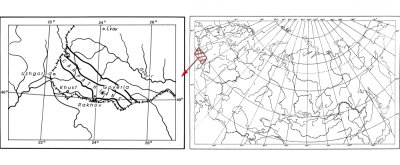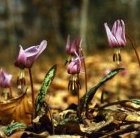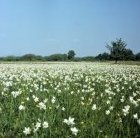 |
QUICK SEARCH
MO PROJECTS:
Africa
Asia/Pacific
Mesoamerica
North America
South America
General Taxonomy
Photo Essays
Training in Latin
America
MO RESEARCH:
Wm. L. Brown Center
Bryology
GIS
Graduate Studies
Research Experiences
for Undergraduates
Imaging Lab
Library
MBG Press
Publications
Climate Change
Catalog Fossil Plants
MO DATABASES:
W³MOST
Image Index
Rare Books
Angiosperm
Phylogeny
Res Botanica
All Databases
INFORMATION:
What's New?
People at MO
Visitor's Guide
Herbarium
Jobs & Fellowships
Symposium
Research Links
Site Map
Search
ORNAMENTAL PLANTS IN THEIR NATURAL HABITATSThe Carpathians Ukraine
Unlike the other center of the FSU, the floras of which have only recently been explored for ornamental species, the Carpathians is an old center of diversity, and many of its species have long been in cultivation. The Carpathian mountains are situated in central and eastern Europe. Their total extent and area are nearly the same as those of the Alps, though their height is much lower. The name "Carpathian" was listed as early as the 11 century A. D., in Ptolemy's "Guide to Geography". Czech scientist P. J. Safarik (1795-1861) believed that it was derived from the Slavic "Kharbat" mountain range. The Carpathians lie only partially within the FSU. They are situated on the borders of the Ukraine with Poland, Czech Republic, Slovakia,
The climate of the Carpathians is a combination of two types: western Atlantic and southeastern continental. The local climate depends on exposure and altitude. East-facing slopes have raw winters, where winds from the Russian plains are frequent. Summer is the rainy season, with a secondary maximum precipitation in late autumn. There are no places with a moisture deficit. Most of the Carpathians are covered by lush forests dominated by common oak (Quercus robur) and common beech (Fagus sylvatica); species of ash, lime, and elm are also found. In the understory are trees of hornbeam (Carpinus betulus) and wild apple (Malus sylvestris). The accompanying herbaceous flora is abundant and diverse. It includes numerous ornamentals, such as Campanula trachelium, Euphorbia cyparissias, Lunaria rediviva, Polygonatum multiflorum, Pulmonaria rubra and Symphytum cordatum. Most of the woody and herbaceous plants of the forest belt are widespread and well-known in gardens. New discoveries can frequently be made among local endemic plants. Chopik (1976, 1977) showed that the greatest number of endemic species (47 or 9.9%) can be seen in the subalpine belt. The alpine belt (10 species, 2.1%) and the foothills (3 species, or 0.6%) have fewer endemic species. The total number of high mountain endemics is about 5% of the entire flora, and some are ornamentally attractive. Most of the herbaceous ornamentals belong to the families Caryophyllaceae, Liliaceae, Lamiaceae and Scrophulariaceae, each of which contains at least 10 species of interest. The Asteraceae, Campanulaceae, Ranunculaceae and Rosaceae are fairly abundant. The plants have many different life-forms with different growth rhythms. Galium odoratum [=Asperula odorata] can grow continuously throughout the year, as it lacks a dormancy period. In contrast, there are ephemeroids and species with deep dormancy, such as Arum alpinum [=A. maculatum], Anemonoides nemorosa [=Anemone nemorosa] and Crocus heuffelianus. The herbaceous species include diverse groups, ranging from xerophytes to mesophytes. Many herbaceous species of the Carpathians also grow in other parts of the FSU. On the other hand, the Carpathians constitute the eastern boundary for some European species that do not occur elsewhere in the FSU (e.g. Colchicum autumnale). The plants that occur in this part of their distribution area are much more cold-resistant than populations of the same species ocurring in Western Europe, and the perennial herbs of the beech forests seem especially promising for cultivation as ornamentals further north. These include a Christmas rose Helleborus purpurascens and a lungworts with red flowers Pulmonaria rubra and P. filarszkyana. The tall leopard's-bane (Doronicum pardalianches) and the short, odorous pig-salad Aposeris foetida, both of the daisy family, have bright yellow heads. Other ornamental plants include an evergreen cranesbill with puple-brown flowers Geranium phaeum, the beautiful white-flowered Melittis carpatica of the mint family, a cornflower Centaurea mollis with its very nice blue-pink flowers and the showy daffodil Narcissus angustifolius. The most distinctive plants of the Carpathian alpine and subalpine meadows include Arnica montana, Campanula alpina, Bistorta major and the common globeflower Trollius europaeus. Some habitat-restricted endemic ornamentals, growing only in specific rocky places, are Alchemilla czywczynensis, A. turkulensis, A. zapalowiczii and Euphorbia carpatica. Some promising ornamentals can grow under various environmental conditions, e.g., Centaurea marmarosiensis, Fritillaria meleagris, Gentiana laciniata and Pulmonaria filarszkyana. Botanical exploration of the Carpathians can start from nearbay cities, such as Rakhov, Khust and Chernovtsi, from which one can reach the Golerla Mts., Chorna Gora, Marmarosh Chain and other mountains. Travelling in the Carpathians is easier than in Central Asia, the Far East and the Caucasus. There are many roads, and the mountains are not as challenging. Current reforestation projects of the Carpathians are introducing Asian, Caucasian and North American tree species for a diverse mix. In the western "Forest Carpathians," near the "Rovnaja Alpine Meadow" (Polonina in Ukrainian), one can find the Siberian pine, Pinus sibirica, of North Europe and Siberia, Schrenk's spruce, Picea schrenkiana, of Central Asia and blue spruce, Picea pungens, of North America. Many Carpathians plants are also grown in the botanical gardens of the FSU, e.g in the cities of L'vov, Kiev, St. Petersburg and Moscow. In one final conclusion, one must add that, although exploring the possibilities of finding new ornamental plants has been restricted herein to the five richest regions of the FSU, there are other parts with equally interesting plant species. Therefore let this book serve as an introduction, and this subject merits further detailed study. |
|||||||
| ORNAMENTAL PLANTS FROM RUSSIA |
© 1995-2025 Missouri Botanical Garden, All Rights Reserved
4344 Shaw Blvd.
St. Louis, MO 63110
(314) 577-5100
Technical Support






